Hey there, art lover! Ever heard of Rogan Art? No, it’s not a type of food—it’s a super old painting style from Kutch, Gujarat. This art is almost 400 years old, and guess what? Only one family in the whole world still does it today. Yep, just one!
Rogan Art is really special. Artists use thick paint made from castor oil (the same oil grandma uses for hair!) and draw beautiful designs by hand on fabric. It takes a lot of time and patience. Years ago, this art was almost lost, but thanks to the Khatri family, it’s alive and shining again!
Here’s a fun fact: There are now fewer than 10 Rogan artists left. That makes it one of the rarest art forms ever!
So, come along as we explore this amazing art and meet the family that is keeping the magic of Rogan Art alive, one paint stroke at a time!
What is Rogan Art?
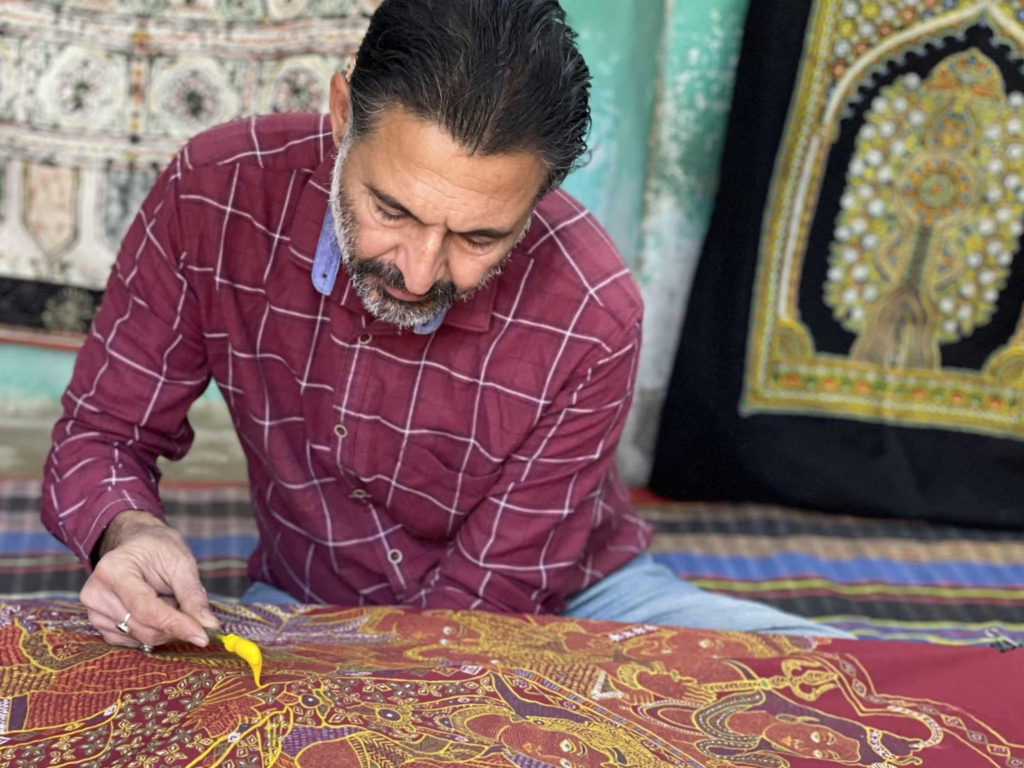
Imagine painting with jelly made from castor oil—sounds strange, right? But that’s exactly what Rogan Art is all about! This amazing art form is over 400 years old and is practised only by a small group of artists in Nirona village, Kutch, Gujarat. The word Rogan comes from Persian, meaning “oil-based,” and that’s exactly what it is—art made using boiled castor oil mixed with bright colors.
The designs are hand-drawn on fabric, with no machines or even pencils. Just a thin metal stick, a steady hand, and lots of patience! The artists paint one side of the fabric and then fold it to create a mirror image on the other side. Cool, right?
Rogan Art is super rare today. At one point, it was almost gone from the world! But one family—the Khatri family—kept it alive. Their hard work has brought this beautiful art back into the spotlight, and now it’s getting love from all over the world.
Now, let’s dig into how this colorful magic is made and where it all began!
Castor Oil and Magic: The Basics
Okay, so how does this “painting with oil” really work?
First, the artist takes castor oil, the same one used for hair and tummy troubles (yes, that one!), and boils it for 12–14 hours until it becomes a thick, sticky paste. This thick jelly is then mixed with natural colors like red, blue, yellow, green, and even gold. The result? A smooth, glossy paint that works like magic.
But wait—Rogan Art has no brushes! Instead, artists use a special metal stick called a kalam. They dip the stick into the paint and stretch the color in the air before placing it on the fabric. It’s like painting with air and jelly!
Here’s what makes the process so special:
- No sketching, no tracing – everything is done freehand.
- Mirror image magic – the design is made on one side, then the cloth is folded to print the same pattern on the other side.
- Tiny details – even the smallest dots and swirls are drawn with care.
- Nature-inspired designs – peacocks, flowers, trees, and the famous Tree of Life are common patterns.
- Time-taking art – one piece can take days or even weeks to finish!
Once finished, the artwork is left to dry and becomes a long-lasting, colorful design on cloth. These days, Rogan Art is being used on more than just traditional clothes. You’ll see it on:
- Wall hangings
- Handbags
- Sarees and kurtas
- Souvenirs and gifts
This art form turns simple castor oil into something truly magical. It’s not just about colours—it’s about storytelling, patience, and a whole lot of skill.
From Persia to Kutch: A Travelling Tradition
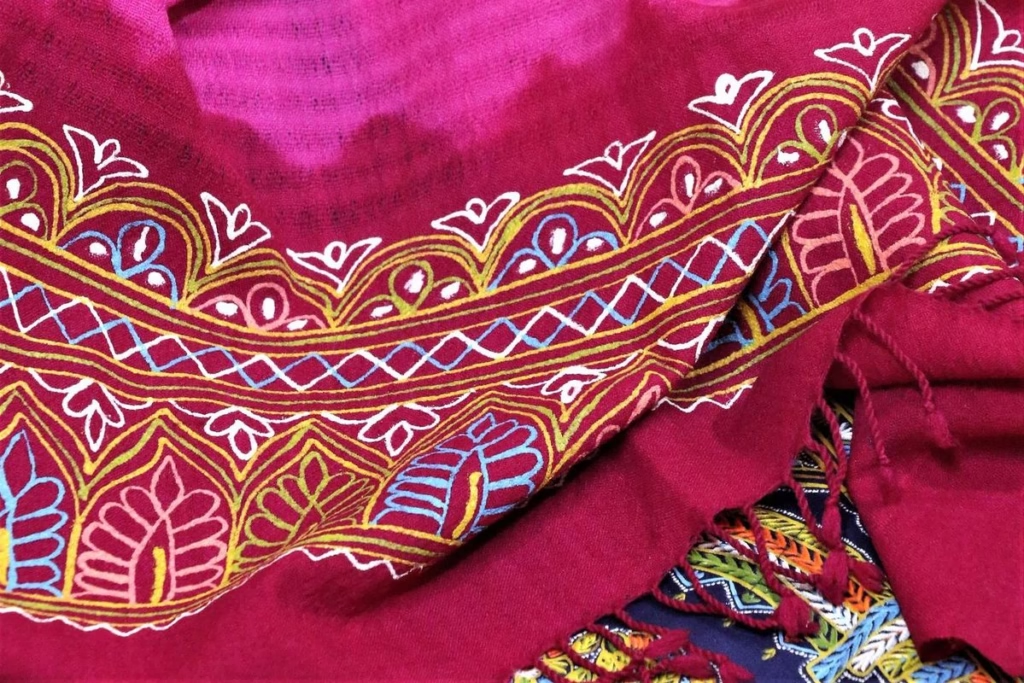
Let’s take a trip through time and see how Rogan Art made its way to India.
Rogan Art didn’t start in India—it came from Persia (now Iran) over 400 years ago. Back then, skilled artists and traders carried it with them as they moved across lands. It eventually settled in Nirona village in Kutch, Gujarat, where it found the perfect home.
Why Nirona? Because:
- Castor plants grow well there – perfect for making Rogan paste.
- A few families were trained in this rare craft.
- The desert climate helped preserve fabric and colors longer.
Rogan Art became part of everyday life. People used it to decorate:
- Bridal clothes and ghaghras
- Bedspreads and pillow covers
- Curtains and home décor
But things changed. Machine-made fabrics became cheaper and faster. Handmade art like Rogan slowly faded away. By the early 2000s, only the Khatri family was left practicing this art. That’s right—just one family in the whole world!
Thankfully, the Khatris didn’t give up. They:
- Taught others through workshops
- Showcased their work around the world
- Kept traditions alive with modern touches
A proud moment? When Prime Minister Modi gifted a Rogan painting to U.S. President Barack Obama—what a way to shine on the global stage!
Today, Rogan Art is slowly rising again. Though there are fewer than 10 practising artists, their work is now seen in:
- Museums and exhibitions
- Home décor stores
- Tourist markets in Kutch
From the deserts of Persia to the dusty lanes of Nirona, this art form has truly travelled far. Thanks to one family’s passion, Rogan Art is glowing bright once more.
The Khatri Family: Guardians of Tradition
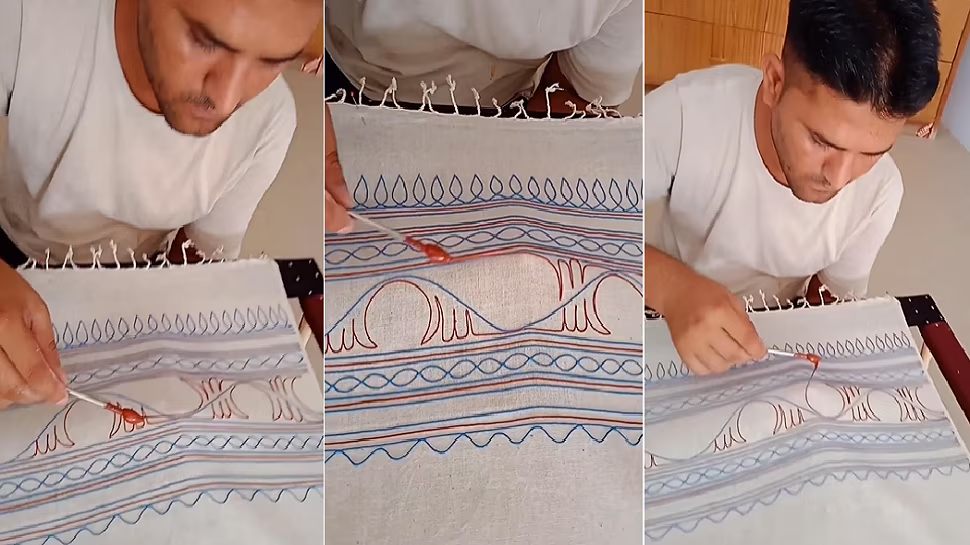
If the world of Rogan Art had a royal family, the Khatris of Nirona would wear the crown—made of castor oil and colored jelly, of course!
For over eight generations, this humble yet mighty family has been guarding a 400-year-old tradition that almost vanished. While the rest of the world leaned toward technology and machine-made fashion, the Khatris stayed loyal to their roots—literally drawing history by hand. At one point, they were the only family on the entire planet still practising Rogan Art. Yes, just one!
They didn’t just preserve it—they revived it. From dusty village walls to global art galleries, the Khatri family put Rogan back on the map, one line at a time. Today, their colourful workshop is more than just a studio—it’s a living museum, a learning school, and a global cultural hotspot.
Through years of hard work, creativity, and love for the craft, they’ve turned Nirona into a name known to art lovers worldwide. So, while the castor oil may be sticky, the Khatris’ commitment to Rogan Art is rock solid.
Let’s now zoom in on their village, their legacy, and the beautiful balance of faith and family that keeps this tradition alive.
The Village of Nirona: Rogan’s Home Base
Welcome to Nirona, a small, peaceful village in Kutch, Gujarat. From the outside, it may look like just another quiet corner of India—but don’t be fooled! This little place holds a giant treasure: the last living home of Rogan Art.
Over the years, Nirona has become a magnet for curious travelers, art lovers, and even global leaders. Why? Because it’s where the magic of castor oil and color comes to life—on humble cloth, through the skilled hands of the Khatri family.
Why Nirona matters:
- Home of the last Rogan artists – All current Rogan Art masters belong to this village.
- Visited by people from over 40 countries – Tourists love the interactive workshops!
- Easily reachable from Bhuj – Just a short road trip brings you to this heritage hotspot.
- Art is part of daily life here – The sound of kalam sticks tapping cloth is just part of the soundtrack.
Even though the village is small, the impact it makes is huge. Rogan Art has turned Nirona into:
- A learning hub, where young students come to train.
- A photo-favorite spot, especially for art bloggers and Instagrammers.
- A souvenir paradise—you can buy hand-painted clothes, bags, and wall hangings directly from the artists.
Locals take great pride in their roots, and the sense of community here is heartwarming. Visitors are often treated like family, and it’s not rare to be offered a cup of chai while admiring a Rogan piece.
In short, Nirona may not have malls or movie halls, but it’s got something way cooler—a living piece of art history. It’s the heart where Rogan Art beats strong every single day.
Abdul Gafur Khatri: The Face of a Legacy
Meet Abdul Gafur Khatri, the man who didn’t just learn Rogan Art—he gave it a second life. Known lovingly as Gafurbhai, he’s the most well-known face in the world of Rogan, and for all the right reasons!
Back when people had almost forgotten about this art, Gafurbhai stayed loyal to it like an old friend. Instead of choosing a flashy job in the city, he picked up the kalam, dipped it in tradition, and created a legacy.
His achievements speak louder than words:
- Awarded the Padma Shri in 2019 – One of India’s highest civilian honors.
- Represented India globally – His artwork has traveled to the U.S., Europe, and beyond.
- Created the famous “Tree of Life” painting gifted to Barack Obama by PM Modi.
- Trained over 100 students from India and abroad in Rogan Art.
What makes him special isn’t just his skill—it’s his passion to preserve, teach, and share this dying tradition. He turned a fading family craft into a global brand of Indian culture.
Even in interviews, Gafurbhai stays humble. He often says, “We are not artists—we’re just doing what our ancestors did with love.”
Fun facts about Gafurbhai:
- He can finish a small Rogan piece in under two hours—talk about steady hands!
- He believes in never rushing the art. Patience, he says, is part of beauty.
- He is teaching his sons and nephews, making sure the art stays in the family.
With every design, Gafurbhai keeps a piece of history alive. His work proves that even one person, with enough dedication, can make the world take notice of something truly unique.
In short, if Rogan Art has a modern-day superhero—it’s Abdul Gafur Khatri with his magical kalam and timeless vision.
Family, Faith, and Fine Lines
Behind every Rogan masterpiece is more than just technique—it’s family love, strong faith, and a daily dose of teamwork. The Khatri household in Nirona isn’t just a home; it’s an art studio, a classroom, and a legacy factory all rolled into one.
Everyone has a role to play:
- The elders share stories and old techniques.
- Parents teach children the art during school breaks.
- Kids mix colors and help fold fabrics.
- Women contribute by preparing materials and even painting!
The Khatris blend their daily life with art so beautifully that you’d barely notice where one ends and the other begins. They paint, eat, chat, and pray together. Before starting any major piece, it’s common to say a small prayer—inviting blessings into every stroke.
Here’s what keeps their bond strong:
- Faith – A deep belief that Rogan is a gift passed down by ancestors.
- Communication – Whether discussing patterns or family gossip, they do it together.
- Food and chai – Meal times are sacred and often involve sharing ideas.
The younger generation isn’t running from tradition—they’re running with it. While some families move away from their roots, the Khatris are proudly digging deeper into theirs.
They are also:
- Experimenting with new designs like abstract and modern styles.
- Selling online to reach younger customers.
- Using social media to share their journey and teach the world about Rogan.
This perfect blend of tradition and teamwork is what makes their art so special. Every painting holds not just color and design, but a big piece of their heart and history.
So yes, it’s not just about fine lines—it’s about fine love, fine patience, and a family that refuses to let this beautiful craft fade away.
The Rogan Revival
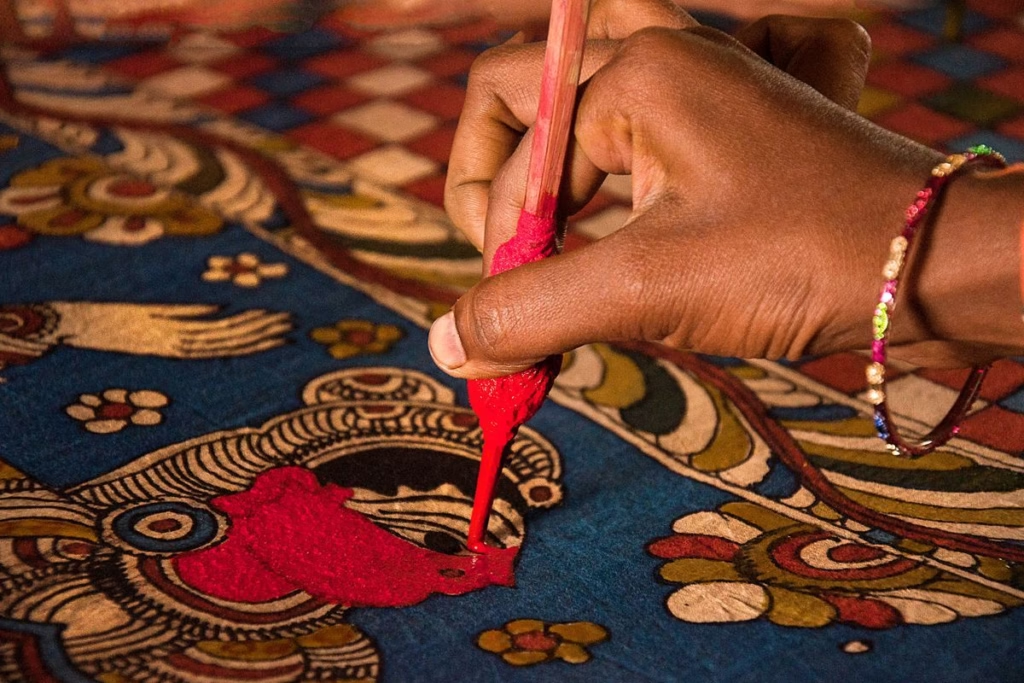
There was a time when Rogan Art was nearly forgotten, quietly surviving in a single village, practiced by just one family. It was like an ancient treasure hidden away, unknown to most of the world. But things have changed—big time. Today, Rogan Art is back in the spotlight, and the credit goes to the dedication of the Khatri family and a little help from a very powerful fan.
This colorful and detailed art form has slowly walked its way from village huts to global art fairs, museums, and even presidential offices. It’s no longer just a village secret—it’s a national treasure that’s being noticed by people across the world.
With new interest from students, tourists, art lovers, and even politicians, Rogan Art is going through a full-blown revival. From social media posts to handmade souvenirs, this centuries-old painting style is being loved again.
So, what helped Rogan Art go from “almost lost” to “highly sought after”? Let’s explore how it caught the world’s eye, found its way to high-level gifts, and got a major push when India’s Prime Minister himself became one of its biggest fans.
Art That Caught the World’s Eye
For a long time, Rogan Art was a quiet tradition. Not many people outside Nirona village even knew it existed. But when photos of its colorful designs and detailed lines started showing up online, something amazing happened. People everywhere wanted to know more.
Here’s what helped Rogan Art become popular again:
- Rogan artists started sharing their work on social media, where it got attention from travelers, art lovers, and designers.
- Bloggers and YouTubers who visited Nirona created videos that reached thousands of viewers.
- Art students began showing interest in learning traditional painting styles, and Rogan Art became part of their study projects.
Thanks to this fresh interest, Rogan Art slowly stepped outside its comfort zone. More people started visiting the Khatri family’s workshop to watch the painting process. It was no longer just a family tradition; it was becoming a learning experience for the world.
Other reasons for its growing popularity:
- Indian art festivals began featuring Rogan Art in their exhibits.
- It started appearing in magazines, design shows, and even school textbooks.
- Rogan products like cushion covers, wall hangings, and clothing were sold at craft stores and online platforms.
Tourists visiting Gujarat also played a big role. Many travelers came just to meet the Khatri family and see the art being made. They bought souvenirs and spread the word once they went home.
Even fashion designers started taking notice of the unique designs, and Rogan patterns were seen on sarees, handbags, and scarves. What was once nearly lost had now become a trend.
Rogan Art didn’t change itself to become modern—it just stayed honest and detailed. That’s what made people fall in love with it all over again. It’s a great example of how true art doesn’t fade away—it just waits for the right moment to shine.
From Presidential Gifts to Art Fairs
One of the biggest moments in the story of Rogan Art came in 2014. India’s Prime Minister, Narendra Modi, gifted a Rogan painting of the Tree of Life to the U.S. President Barack Obama during an official visit. That one event made headlines around the world and gave Rogan Art a platform like never before.
This moment was important for many reasons:
- It showed that traditional Indian art can be used in high-level diplomatic exchanges.
- The painting was chosen over thousands of other gift ideas, proving how special Rogan Art truly is.
- It introduced a centuries-old village craft to global leaders and media.
The attention didn’t stop there. After that gift, Rogan Art started getting invitations to national
and international art fairs. These fairs allowed artists from Nirona to showcase their work to buyers, collectors, and curators from across the world.
Other highlights that boosted Rogan’s popularity:
- The art was displayed at cultural exhibitions in cities like Delhi, Mumbai, London, and New York.
- Craft organisations started inviting Rogan artists to workshops, giving them a platform to teach and share their techniques.
- Government-sponsored programs promoted Rogan Art as part of India’s rich cultural heritage.
This helped the Khatri family grow their reach and income. More people began buying Rogan products, and younger members of the family felt encouraged to carry on the tradition.
Tourist fairs and online stores also added to the success:
- Rogan Art began appearing at regional tourism events in Gujarat and Rajasthan.
- Online platforms started featuring handmade Rogan goods with artist backstories.
- Art collectors who once focused on modern art began showing interest in this handmade style.
All of this attention made Rogan Art more than just beautiful decoration—it became a symbol of Indian creativity, skill, and pride. The journey from a tiny workshop in Nirona to world-famous art fairs is proof that no tradition is ever too small to make a big impact.
When PM Modi Met Rogan Art
While the gift to President Obama was a big moment, the real turning point for Rogan Art came when Prime Minister Narendra Modi visited Nirona village himself. This was no small visit—it was a full show of support for the craft, the artists, and the village.
His visit brought sudden attention from across the country:
- National newspapers and news channels covered the story.
- Government cultural bodies started reaching out to the Khatri family.
- State tourism programs began promoting Rogan Art in travel brochures and TV ads.
The impact of Modi’s visit was immediate and powerful:
- Visitor numbers to the Khatri family’s workshop grew four times within a year.
- Schools and colleges began organizing art trips to Nirona.
- Other traditional artists around India felt encouraged to revive their own crafts.
For the Khatris, the visit was more than publicity—it was recognition for years of dedication. The Prime Minister sat with the family, watched them paint, and spoke about the importance of keeping such heritage alive.
What followed:
- Rogan artists were invited to national award ceremonies and cultural conferences.
- Museums began adding Rogan pieces to their permanent collections.
- New workshops were set up with support from government funds to train more young artists.
Modi’s visit also brought pride and confidence to the village. Locals started sharing stories about their heritage more freely. Young children began learning Rogan Art with a sense of joy, not just duty.
Even though Rogan Art had been around for centuries, it took this single visit to make the whole nation stop and look. And when people looked, they didn’t just see colorful lines—they saw hard work, skill, and a living link to India’s artistic past.
That day, Rogan Art wasn’t just a tradition from the past—it became a bright hope for the future.
The Process Behind the Paintings
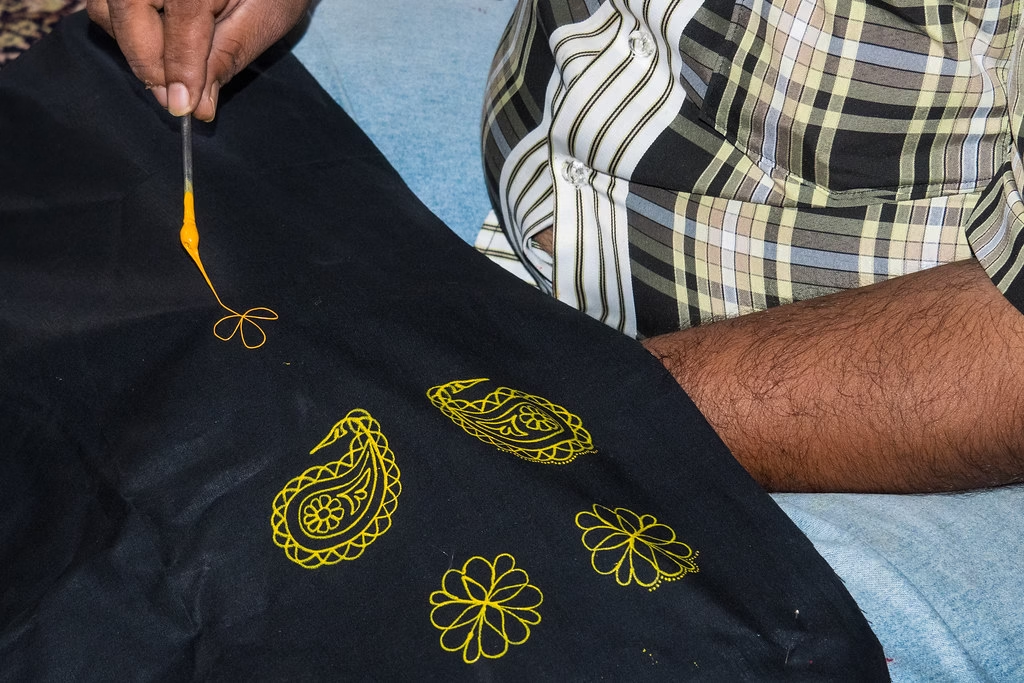
Rogan Art may look magical, but it’s not made by waving a wand. It’s made by hand—very steady hands! The process is slow, detailed, and full of patience. It starts with a strange ingredient—castor oil—and ends with jaw-dropping patterns that make people say, “Wait, that’s handmade?”
This art form isn’t just pretty—it’s a workout for the fingers and eyes. The paint is made by heating castor oil for two days until it becomes a thick, gooey paste. Then, colours are made from natural powders. The artist dips a metal stick into the paint and begins drawing on fabric—without using a pencil or brush.
It’s done freehand, with one side painted first and the other side folded to mirror the design perfectly. There are no erasers here, so even a minor mistake can ruin the entire work. But that’s what makes it so special—every Rogan piece is one of a kind.
Final Takeaway
Rogan Art is not just some old painting style—it’s a real, living tradition full of care, color, and talent. The process may look simple, but it takes years of learning and tons of patience. From boiling castor oil to making tiny lines without any brush, it’s all done by hand with love. And thanks to the Khatri family in Nirona village, this special art is still alive today.
This amazing art, once hidden in a small village, is now seen in big cities, art shows, and even museums. It has become a proud part of India’s culture. With less than 10 artists doing it today, each Rogan painting is rare and full of meaning.
But the good news? More people are noticing it. Young artists are starting to learn, and even the world is showing interest. As long as the Khatris keep painting, Rogan Art will stay alive and keep growing—one colorful line at a time.
Check out our Blog Page on Traditional Indian art.

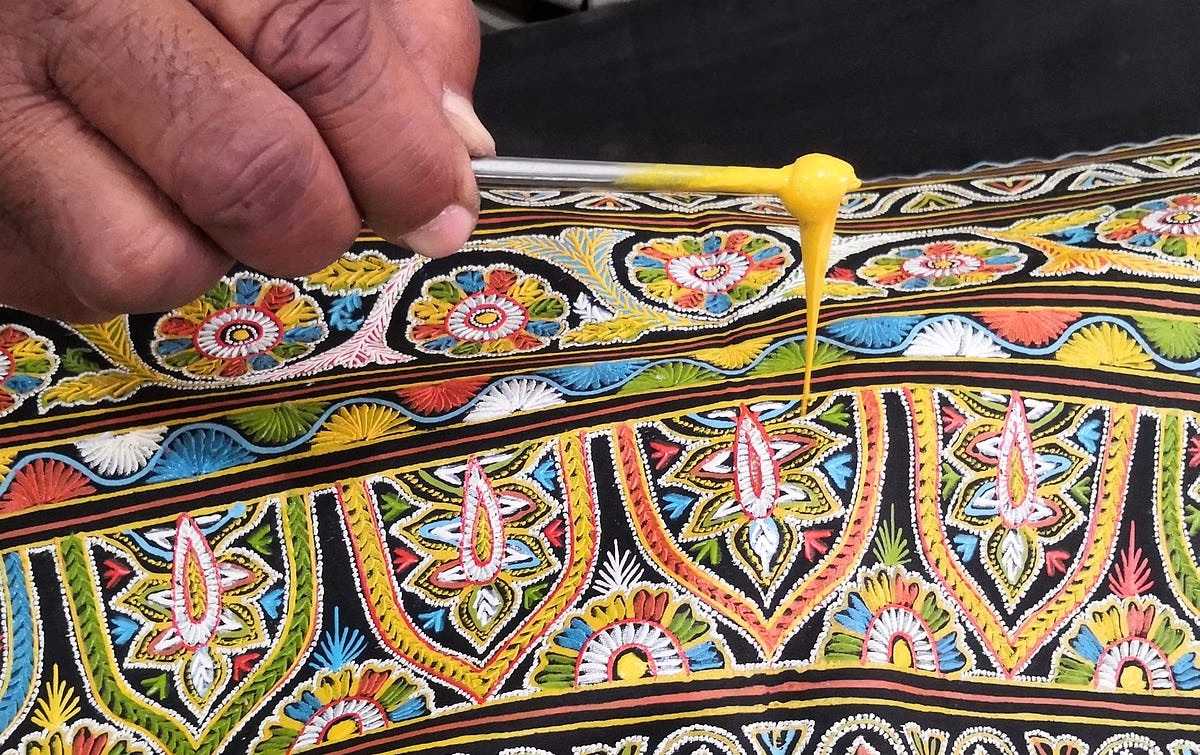
Leave a Reply